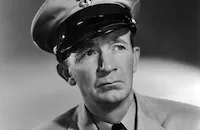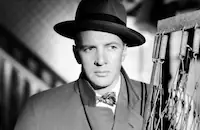Task Force

Brief Synopsis
Cast & Crew
Delmer Daves
Gary Cooper
Jane Wyatt
Wayne Morris
Walter Brennan
Julie London
Film Details
Technical Specs

Synopsis
As Jonathan L. Scott faces retirement from the Navy, he recalls twenty-seven years earlier when he was a Navy pilot stationed in San Diego: The first aircraft carrier in 1921 is a converted collier, the Langley . Because the Navy does not have the money to purchase airplanes especially designed to land on carriers, several pilots die as they attempt to land on the sixty-five foot deck. One day, Scott must tell Mary Morgan that her husband Jerry has been killed. In 1923, Scott is transferred to Washington, D.C. to help develop a carrier plane and to convince the admirals to support naval aviation. At a party he encounters Mary, who is there with another officer. Scott becomes involved in an argument with powerful isolationist newspaper publisher Bentley and thus greatly angers Admiral Ames. Scott is then assigned to a desk job at the Panama Canal. Before he leaves, Scott proposes to Mary, who refuses to marry another flyer, but advises him to continue his fight for the carrier planes. When a newly designed carrier, the Saratoga , is launched, Scott is transferred to it. Learning to fly with a new system, Scott loses control of his plane and crashes. While he is recovering, Mary visits the hospital and accepts Scott's second proposal. The couple spends two years in Hawaii and then moves to Annapolis, where Scott, now a Lieutenant Commander, is to teach naval aviation. His outspoken stand in favor of aircraft carriers in combat causes him to lose a promotion, and after Japan invades Manchuria, Scott decides to accept a civilian job selling planes in Europe. Mary, however, encourages him to remain in the Navy, and they return to Hawaii, where Scott is made a commander. When Pearl Harbor is attacked by the Japanese, Scott's ship, the Enterprise , sets out to prove the worth of the carrier. During the Battle of Midway, the flight deck is badly damaged by Japanese torpedo planes, and they are forced to abandon ship. Afterward, Scott is made a Captain and travels to Washington to plead for more carriers. Eventually a carrier fleet is produced, and Scott is placed in charge of one of the ships. During the Battle of Okinawa, the fleet proves its worth, and four years after the end of the war, Scott retires and joins Mary, who is waiting for him on the dock.

Director

Delmer Daves
Cast

Gary Cooper

Jane Wyatt

Wayne Morris

Walter Brennan

Julie London

Bruce Bennett

Jack Holt

Stanley Ridges

John Ridgely
Richard Rober
Art Baker

Moroni Olsen
Ray Montgomery

Harlan Warde
James Holden
Rory Mallinson

John Gallaudet

Warren Douglas
Charles Waldron Jr.

Robert Rockwell
William Gould
Sally Corner

Kenneth Tobey
Tetsu Komai
Beal Wong
Laura Treadwell
Roscoe Behan
Basil Ruysdael
Raymond Bond
Edwin Fowler
William Hudson
Mary Lawrence
John Mcguire
Charles Sherlock
Reed Howes
Mal Merrihugh
Mickey Mccardell
Paul Mcwilliams
Larry Rio
Alex Gerry
Frank Jacquet
Joe Forte
Robert Manning
Charles Williams
Brad Evans
Gerard Waller
Fred Marlowe
Tommy Walker
Richard Paxton
David Alison
Alan Ray
Joe P. Smith
Jack Sterling
William Dorme
Roger Anderson

Gregg Barton
Peter Ortiz
Stan Johnson
Joel Allen
Jack Shea
John Mckee
Crew
Robert Burks
Wilfrid M. Cline
Alan Crosland Jr.
Delmer Daves
Roy Davidson
Edwin Dupar
Captain James Dyer Usn Ret
William Fritzsche
George James Hopkins
Natalie Kalmus
Bill Kissel
Leo K. Kuter
Charles Lang
Paul Mantz
Captain S. G. Mitchell Usn
Leonid Raab
Leah Rhodes
Eric Stacey
Jerry Wald
Franz Waxman
Perc Westmore

Photo Collections
Film Details
Technical Specs

Articles
Task Force
While some may view Task Force as little more than a World War II propaganda film for the U.S. Navy, there is another, more revealing aspect to the story, one that shows how slow the wheels of progress can turn within our government bureaucracy. It is only through Scott's aggressive campaign for change that his vision for naval aviation is adopted after years of lobbying. Adding an additional note of realism to the film is the use of World War II footage taken from the Battle of Midway and the subsequent kamikaze attacks by the enemy.
During the making of Task Force, Cooper came close to being seriously injured twice. The first time occurred during gunnery practice on the aircraft carrier, USS Antietam, when the actor and several cast members were almost struck by a robot target plane that caught fire and skimmed over the deck before crashing into the ocean. The second mishap took place as Cooper was riding in a naval barge that broke up on a rocky edge of Long Beach Harbor in the midst of a thick fog bank. Luckily, the sinking barge was located in time by another naval vessel and Cooper was rescued but later hospitalized with a severe cold and high fever.
Task Force, directed by Delmer Daves, was well received by both the critics and moviegoers with special praise going to Cooper's performance as Scott. But, according to the biography Coop by Stuart Kaminsky, the actor had little regard for the movie. "When asked about his performance by Hedda Hopper, Cooper replied, "The main thing I remember about that film is that it interfered with my fall hunting." Copper then claimed he had made the film for money and that, in spite of the fact that he was getting more than $300,000 a picture, his expenses, including a newly acquired seventeen-acre home in Colorado, kept demanding more."
Producer: Jerry Wald
Director: Delmer Daves
Screenplay: Delmer Daves
Art Direction: Leo K. Kuter
Cinematography: Robert Burks, Wilfred M. Cline
Editing: Alan Crosland, Jr.
Music: Franz Waxman
Cast: Gary Cooper (Jonathan L. Scott), Jane Wyatt (Mary Morgan), Wayne Morris (McKinney), Walter Brennan (Pete Richard), Julie London (Barbara McKinney), Bruce Bennett (McCluskey), Jack Holt (Reeves).
BW &C-117m. Closed captioning.
by Jeff Stafford

Task Force
Kenneth Tobey (1917-2003)
Born in Oakland, California on March 23, 1917, Tobey originally intended to be a lawyer before a stint with the University of California Little Theater changed his mind. From there, he went straight to New York and spent nearly two years studying acting at the Neighborhood Playhouse, where his classmates included Gregory Peck, Eli Wallach and Tony Randall. Throughout the '40s, Tobey acted on Broadway and in stock before relocating to Hollywood. Once there, Tobey soon found himself playing a tough soldier in films like I Was a Male War Bride and Twelve O' Clock High (both 1949); or a tough police officer in Kiss Tomorrow Goodbye and Three Secrets (both 1950). Such roles were hardly surprising, given Tobey's craggy features, unsmiling countenance and rough voice.
Needless to say, no-nonsense, authority figures would be Tobey's calling for the remainder of his career; yet given the right role, he had the talent to make it memorable: the smart, likeable Captain Hendrey in The Thing From Another World (1951); the gallant Colonel Jack Evans in the "prehistoric dinosaur attacks an urban center" genre chiller The Beast from 20,000 Fathoms (1953, a must-see film for fans of special effects wizard, Ray Harryhausen; and as Bat Masterson, holding his own against Kirk Douglas and Burt Lancaster in Gunfight at the O.K. Corral (1957).
Television would also offer Tobey much work: he had his own action series as chopper pilot Chuck Martin in Whirlybirds (1957-59); and had a recurring role as Assistant District Attorney Alvin in Perry Mason (1957-66). He would also be kept busy with guest appearances in countless westerns (Gunsmoke, Bonanza, The Virginian) and cop shows (The Rockford Files, Barnaby Jones, Ironside) for the next two decades. Most amusingly, the tail end of Tobey's career saw some self-deprecating cameo spots in such contemporary shockers as The Howling (1981); Strange Invaders (1983) and his role reprisal of Captain Hendry in The Attack of the B-Movie Monsters (2002). Tobey is survived by a daughter, two stepchildren, and two grandchildren.
by Michael T. Toole
Kenneth Tobey (1917-2003)
Quotes
Trivia
Notes
Delmer Daves's onscreen credit reads: "Written and directed by." The film ends with the following written acknowledgment: "To the United States Navy for its aid and cooperation in making this picture possible our grateful thanks." A press release indicates that Warner Bros. had begun to work on the idea for this film as early as May 1945. According to a news item in June 29, 1948 Los Angeles Times, Robert Montgomery was to star in the film. The item adds that the studio had obtained Technicolor shots of the last six months of the Pacific war.
A October 17, 1948 New York Times article reports that director Delmer Daves and producer Jerry Wald found original black and white footage of the Langley, shot in 1923 at the silent speed of 16 frames per second. Similar footage was discovered of the Saratoga, an intermediate stage in the development of the aircraft carrier. By optical processes the old film was adjusted to the sound speed of 24 frames per second. In order to incorporate this footage, Wald decided to shoot the first half of the film in black and white and switch to color with the scenes of the Enterprise at Pearl Harbor. World War II footage includes shots of the Battle of Midway, the Japanese attack on the Yorktown and kamikaze damage to the Franklin. The article also names Patricia Neal as a member of the cast, but she did not appear in the completed film.















